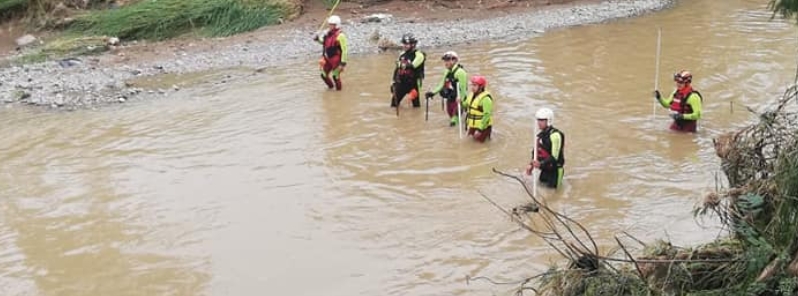Tropical Depression “Hanna” barrels through Mexico, leaving 11 people dead or missing

After making landfall in Texas as Category 1 hurricane, Hanna weakened into a tropical depression as it barrelled through Mexico, bringing severe flooding that caused considerable property damage, killed at least five people, and left six others missing in the northeast states on Sunday, July 26, 2020.
The National Meteorological Service registered 533 mm (21 inches) of rain in 24 hours to Monday, July 27 in Monterrey, Nuevo Leon; 210 mm (8 inches) in Tamaulipas, and 87 mm (3 inches) in Candela, Coahuila. Rio Bravo in Tamaulipas saw 168 mm (7 inches) of rain the previous day.
Two people lost their lives while three others went missing after heavy downpour triggered severe flooding in Monterrey City.
A vehicle containing members of the same family was dragged down an overflowing tributary. Some of the passengers managed to escape, including an 11-year-old girl who survived by clinging to branches. However, her 7-year-old sister and their mother died; their bodies were retrieved in Saltillo on Monday.
Electrical power was disrupted in large sections of the city and neighboring areas. Flooding also cut off the road linking Monterrey to the border city of Reynosa.
A woman died in the area after suffering a seizure and drowning in the floodwater. In a nearby neighborhood, three children went missing after falling from a tree into the water.
In Coahuila, two people died after floodwaters brushed away their vehicle in Ramos Arizpe.
According to the National Center for Prevention of Disasters (CENAPRED), Hanna caused considerable property damage in the affected states.
"Among the damages are flooded roads, towed vehicles, flooded homes; billboards, poles and fallen trees causing outages in the electrical power supply; ruptures in the asphalt binder and dragging of material in low areas."
Meanwhile, a video reportedly showing a section of the Mexican-U.S. border wall being toppled by high winds is making rounds on social media.
However, the U.S. Customs and Border Protection (CBP) invalidated the footage, saying that they are "not aware of any border wall panels falling over due to Hurricane Hanna hitting the Rio Grande Valley Sector this past weekend."
CBP told Forbes that the video was actually taken in June, at a Department of Defense construction site in New Mexico.
In an update published Monday, CENAPRED reported that Hanna has weakened but more rains are still forecast in the north, particularly in Coahuila, Nuevo Leon, Zacatecas, Durango, San Luis Potosí, Sinaloa, Nayarit, Jalisco, and Tamaulipas
Hurricane Hanna – A section of the #US – #Mexico border wall allegedly collapses under the strong winds pic.twitter.com/KfsjLDpnn2
— freezerohedge (@freezerohedge) July 27, 2020
Evite salir esta noche en zonas de carreteras está la situación con mucho riesgo por inundaciones y deslaves tramo los arroyos de Saltillo a Matehula SLP compartido por profAlonso del grupo Whats @TiempoSeveroMex #Hanna pic.twitter.com/W4pmooLROW
— IngGeofisico (@ChaacTlaloc) July 27, 2020
Hurricane Hanna, the first of the 2020 Atlantic season, swamped Mexico's Monterrey pic.twitter.com/PNAGErapIT
— Reuters (@Reuters) July 27, 2020
This animation shows IMERG rain rates (blue/yellow shading) and accumulations (green shading) observed from July 22 – 26, 2020 along Hurricane Hanna’s track as it crossed the Gulf of Mexico and reached southern Texas and northeastern Mexico. The National Hurricane Center began tracking the tropical depression that would become Hanna on July 23, shown here as a red line, smoothed in time. Hanna continued to strengthen into a Category 1 hurricane with a clearly visible eye on July 25 when it made landfall in southern Texas at 22:00 UTC. During Hanna’s approach, IMERG observed rain rates in excess of 25 millimeters/hour (~1 inch/hour; yellow shading). Accumulations during Hanna’s passage exceeded 20 centimeters (~8 inches; dark green shading) in parts of southern Texas and northeastern Mexico.
As Hanna barreled across the Atlantic Ocean this weekend, both Texas and Mexico braced for disaster. While Mexico saw deaths and extensive flooding, Texas witnessed the storm making records– the state has now nine hurricane landfalls in July since 1851, which is more than any other state in the U.S.
Hanna was also the first rapidly-intensifying named storm of the 2020 Atlantic hurricane season. Its landfall on Padre Island packing winds of 150 km/h (90 mph) made it the strongest July hurricane in Texas since Claudette in 2003.
The storm's central pressure of 973 hPa was the lowest for a July hurricane in the Gulf of Mexico since Alex in 2010, and the first to make landfall in Texas in July since Dolly in 2008.




Featured image credit: Nuevo Leon Civil Protection

Commenting rules and guidelines
We value the thoughts and opinions of our readers and welcome healthy discussions on our website. In order to maintain a respectful and positive community, we ask that all commenters follow these rules.